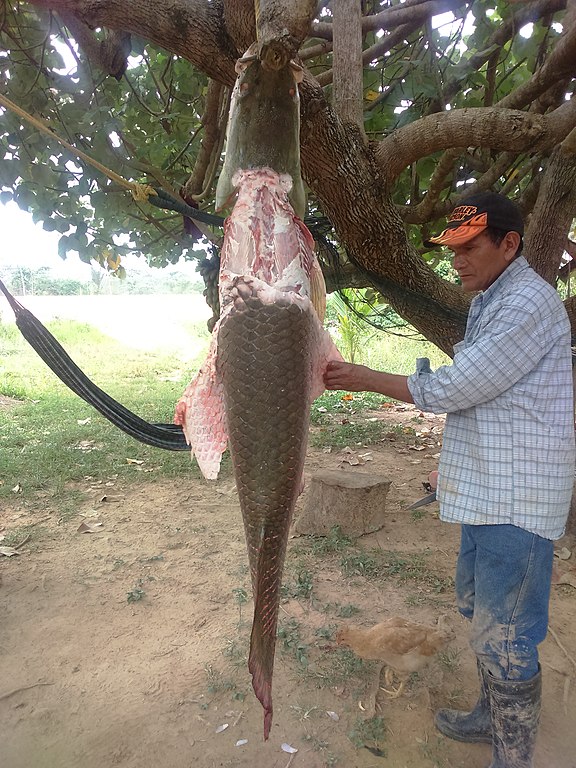Paiche:
What is it?, history, cultivation, nutritional value, uses, recipes, and more...
The paiche, whose scientific name is Arapaima gigas, is the largest fish in the Peruvian Amazon and the second-largest freshwater fish in the world. It can measure approximately 3 meters in length and weigh 200 kilograms. This creature inhabits mainly in Peru and Brazil and has been a significant part of the diet for communities in the Amazon region.
Índice
What is the Paiche?
The paiche is a large fish that can reach lengths of over 3 meters and weigh between 100 to 200 kg. Its head is small relative to its body, representing approximately 10% of its total weight. The head is covered with 58 plates of varying sizes distributed across its surface, with about 6 to 8 pores along its rear edge, through which it excretes a whitish mucus. Its body is elongated, cylindrical, and ellipsoidal in shape. It possesses thick cycloid scales and has pectoral fins separated from the ventral fins, while the dorsal and anal fins are close to the caudal fin.
The paiche is typically light brown with orange spots near its posterior end. It also features two symmetrical fins on each side of its body at the posterior end.
One of the curiosities of this creature lies in its tongue; it has a bony, toothed tongue, a distinctive characteristic of species in the Osteoglossiformes order. This tongue is a bony structure measuring 25 cm in total length and 5 cm in width, equipped with filamentous teeth.
The paiche’s respiratory system is complex. It possesses gills and a swim bladder adapted as a lung, which necessitates its regular trips to the water’s surface for breathing.
History of the Paiche
Due to its taxonomy, the paiche belongs to the superorder Osteoglossomorpha, a group of primitive fishes that, with the exception of the Hiodontidae family, are tropical. The Osteoglossomorpha encompass six existing families, 206 species, and have existed since the Cretaceous period (65 to 136 million years ago). They are believed to descend from primitive bony fishes.
From ancient times, the paiche has been an important source of food, essential in the diet of many communities. Even its scales have played a role in the development of these communities. These scales can be used for crafting items like leaves, artificial flowers, dreamcatchers, and adornments in traditional clothing. Its unique bony tongue is used as a scraper and for grating yucca, as well as for processing guaraná sticks or paste in households.
There’s a legend in Brazil that tells the story of Piracuru, the name of the paiche there. Piracuru was a brave but wicked warrior prince who angered the gods with his insults and acts of violence against his own people. One day, while Piracuru was fishing with some natives, the gods conjured a storm that scattered his companions and struck him in the heart with lightning. He fell into the river and sank while being transformed into a dark fish that terrorized the region for years.
Due to indiscriminate fishing, by 1975 the paiche was considered an endangered species. It was then that the sustainable exploitation of the species began. Its exportation was prohibited, and farmers in Peru and Brazil started implementing breeding programs for the species.

Common Name of the Paiche
| Spanish | pirarucu o bacalao amazónico, arapaima |
| Colombia | Warapaima |
| Guyana | De-chi |
Scientific Name of the Paiche
Arapaima gigas
Taxonomy of the Paiche
| Kingdom | Animalia |
| Filo | Chordata |
| Subfilo | Vertebrata |
| Class | Actinopterygii |
| Order | Osteoglossiformes |
| Family | Arapaimidae |
| Subfamily | Heterotidinae |
| Gender | Arapaima |
| Specie | A. gigas (Cuvier, 1829) |
Synonymy of the Paiche
Sudis gigas Schinz, 1822
Sudis gigas G. Cuvier, 1829 (ambiguous)
Arapaima gigas (G. Cuvier, 1829) (ambiguous)
Sudis pirarucu Spix & Agassiz, 1829 (ambiguous)
Vastres mapae Valenciennes, 1847
Vastres cuvieri Valenciennes, 1847
Vastres agassizii Valenciennes, 1847
Vastres arapaima Valenciennes, 1847
Etymology of the Paiche
Paiche: The word likely comes from the Quechua term “paychim/paychi.”
Arapaima: A term in the Tupí-Guaraní language that indigenous people used to refer to the giant paiche or pirarucú.
Habitat of the Paiche
- Habitat
Habitat of the Paiche
The natural habitat of the paiche is in the Amazon Basin, with Brazil and Peru being its primary producers. Its production is mainly intended for domestic consumption. In Peru, it is found in the basins of the Napo, Putumayo, Marañón, Pastaza, and Ucayali rivers.
This species tends to inhabit calm, dark waters such as lagoons and slow-moving rivers, preferring eutrophic lakes of the third type. Due to its dual respiration system, the paiche can live in waters with low oxygen levels, high organic matter content like aquatic vegetation, and limited water movement or circulation.
In paiche farming, the suitable water temperature typically ranges from 24°C to 31°C. Slightly turbid, neutral to slightly acidic waters are preferred, with a pH ranging from 6 to 8.
Female individuals of the species undergo partial spawning, releasing an average of 200 eggs per kilogram of live weight each time, depending on their age and nutritional state.
Geographical Distribution of the Paiche

Loreto, Ucayali, Tumbes, San Martín
Stationary Availability of the Paiche
- Available in Peru year-round.
Nutritional Value of the Paiche
The paiche contains essential minerals such as iron and zinc, which prevent and combat anemia and chronic malnutrition, especially in children and pregnant women.
It also boasts a high content of omega-3, omega-6, and omega-9 fatty acids, contributing to the prevention of cardiovascular issues, improving brain function, and supporting the nervous system, among other benefits.
This fish provides a significant amount of protein to the body and helps lower elevated cholesterol levels, promotes tissue regeneration, aids in wound healing, and prevents coronary diseases in adults.
Health Benefits of the Paiche
The paiche is an excellent source of protein and omega-3, omega-6, and omega-9 fatty acids. Additionally, it offers essential minerals such as iron and zinc.
Contraindications or Side Effects
As of now, there is no evidence suggesting adverse effects or drug interactions related to its consumption. It is only advised to avoid consumption in cases of fish and seafood allergies.
| 10 Porciones por Kilogramo | |
| Tamaño de porción | 100g |
| Cantidad por porción Calorías |
247 |
| Cantidad por 100g | |
| Energía | 1,033 kJ |
| Grasa Total | 9.3 g |
| Sodio | ● |
| Carbohidratos totales | 0.0 g |
| Carbohidratos disponibles | ● |
| Fibra Dietaria | ● |
| Proteínas | 38.2 g |
| Calcio | 50 mg |
| Fósforo | 209 mg |
| Zinc | ● |
| Hierro | 3.30 mg |
| Potasio | ● |
| Agua | 40.4 g |
| Cenizas | 9.5 g |
| Vitamina A | ● |
| Tiamina (B1) | 0.01 mg |
| Riboflavina (B2) | 0.12 mg |
| Niacina (B3) | 5.60 mg |
| Vitamina C | ● |
| Acido Fólico (B9) | ● |
| β-Caroteno | 0 μg |
| Fuente: Tablas peruanas de composición de alimentos – Centro Nacional de Alimentación y Nutrición – Ministerio de Salud – Perú | |
Derived Products and Consumption Methods of the Paiche
Uses of the Paiche
The primary use of the paiche is as a culinary ingredient in various dishes. Its scales and tongue have artisanal uses, and it is also valued for its nutritional properties.
- Culinary
Culinary Use of the Paiche
The meat of this fish is highly sought after in the Peruvian and Brazilian Amazon. Its meat is considered to have an exquisite flavor and the advantage of lacking fine bones.
It is a versatile species in gastronomy, suitable for preparation through methods such as steaming, ceviche, stews, grilling, among others. When dried and salted, it is compared to cod.
Furthermore, it is considered to be easily digestible and quick to digest.



